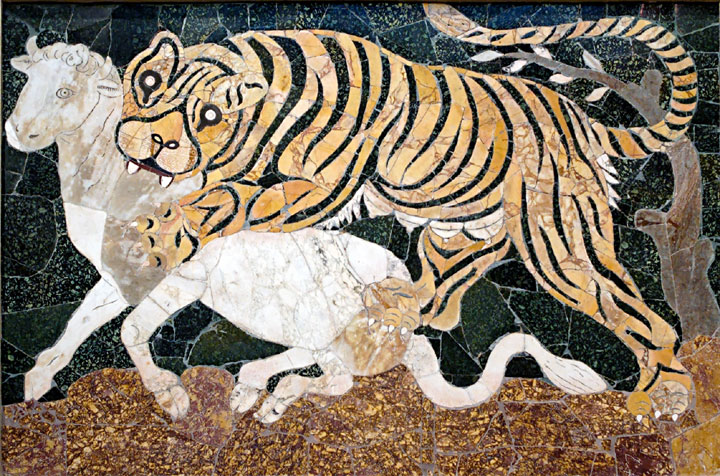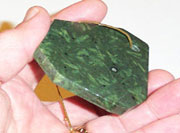Lapis Lacedaemonius (Krokeatis lithos) is a deep green volcanic stone (forest green, Olive) with lighter green spots in it that make it look like mosaic. It is a rare kind of hard stone found only in the region of "Psifi" of our town of Krokees, located in middle of prefecture Laconia, Greece. The area of Psifi ( the hill of Psifi), is for the most part a brush forest/pasture, and only a small part of it is suitable for agricultural cultivation (cultivation of olive trees). Scattered on the landscape are various pieces of Lapis Lacedaemonius some of which are as large as half a cubic meter. The exterior surface of the stone, as it is dug out of the ground, is rusty /oxidized, while the surface of stones scattered on the ground, affected by weather conditions ( hot summer sun) and the passing of time, have changed externally to a point where at first glance they look like ordinary stones. The beauty of stone however is inside and almost every stone has its own unique interior
The geological name given to Krokeatis lithos (Lapis Lacedaemonius) by the department of Civil Engineers of the University of Thrace in northern Greece is Anthesitis , a stone that derives from Diorite ( A more detailed description but difficult to translate is provided in the Greek text. We would appreciate any one's help in translating it )
"Anthesitis is found in many places in Greece, including Thrace, Macedonia and the Aegean islands. A particular type of Antesitis is the Krokeatis lithos in the town of Krokees in Peloponnese."
Although Krokeatis lithos (a type of Porphyry stone) was very hard to work with and shape, in antiquity it was used for the manufacture of vases and state/city seals, and for the decoration of buildings, baths and graves. Historian Frank Frost of the University of California, in his book Greek Society (1971), refers to Krokeatis Lithos (...the prized green porphyry. ) as one of the main raw materials exported by the Myceneans .
Vessels and seals made of Krokeatis lithos, as well as pieces of raw stone, were found at the acropolis in Mycenae and in the excavations at the palace of King Minos in the Knossos, Crete. The famous baths next to the temple of Poseidon in Corinth were also decorated with Krokeatis lithos
The Romans excavated and took large quantities of this stone, which they called Lapis Lacedaemonius, or porphyry from Sparta or green stone from Taygetus , and used it mainly as decorative building material in facades and floorings of luxurious buildings. The stone was likely exported to the various parts of Roman empire via the nearby ancient Spartan harbor at Trinisa, near the three little islands located at the center of the Laconic Gulf shore line. Legend has it that the stones were transported by a brigade of slaves who moved the stones from hand to hand, which explains why one walking the same route today finds pieces of stone scattered around- most likely pieces that were dropped by the workers.
In his memoirs, Paysanias, the famous traveler of that era makes reference to the town of Krokees and the near by quarry of Krokeatis lithos.
A visitor to modern day Rome, Italy might easily distinguish opus sectile ("piece /cut work") with Krokeatis lithos ( Lapis Lacedaemonius ) in the Archaeological Museum of Palazzo Massimo, the basilica of Saint Peter ( Main square), the basilica of Santa Maria Maggiore ( Cosmati, Cosmatesque pavement ), and other ancient buildings. Large quantities of Krokeatis lithos can be found at the palace ( Ruins ) of emperor Domitianus in Trevignano Romano (near Rome), the ruins of ancient Pompey , and the church of Saint Mark in the Venice.
Krokeatis Lithos was also used to decorate Byzantine-era buildings, including the church of Agia Sofia (Pavement & Walls) in Constantinople. In the 1260s, King Henry III used the Krokean stone to decorate the Westminster Abbey ( Cosmati, Cosmatesque pavement ). The stone was used in Cairo, Egypt (pre-Ottoman period) for the decoration of mosques. Krokeatis Lithos was also chosen for the decoration of simple grave of three hundred Spartans in the Thermopile.
Although the stone was difficult to work with in ancient times, Krokeatis lithos can easily be shaped using modern-day tools. With a small investment in tools, and with inventiveness and artistic imagination, Krokeans today could easily start small craft-based enterprises producing high quality decorative products such as vases, statuettes, medallions, desk plaques, beads, jewels, floor tiles, forniture, tables /counter tops and more. These products could be sold in the Greek and international market.
Opus sectile is a way of making decorations using precisely cut pieces of polychrome stone, marble, mother of pearl , and glass to make patterns and figures on flat surfaces. Opus sectile was used in pavings, walls and flat smaller surfaces, such as tables.
Unlike mosaic techniques, where the placement uniformly-sized single color pieces form a design, opus sectile pieces are much larger and can form large parts of the design.
Ppopularized in Rome, the technique of opus sectile was very expensive, therefore it was used only in high status contexts, such as Palaces Basilicas and villas where polychrome mosaics and paintings were not adequate.
In the Villa Romana del Casale , a very rich Roman country villa in Sicily from the 4th century CE with over 3500m 2 of polychrome geometric and figurative mosaics, only one room, the main audience hall where the master of the house received his guests, had a floor in opus sectile .
One of the basic polychrome stones used in opus sectile and Cosmatesque was Krokeatis Lithos ( Roman: Lapis or marmor Lacedaemonius, Serpentine Porphyry, Green porphyry), a dark forest green stone with green and golden spots that make it look like mosaic, a stone found only in the area of Psifi of our town Krokees ( Croceae, Krokeai, Levertsova) in Laconia Greece (southern most area of the Peloponnese ). The ancient quarries of Krokeatis lithos became property of the Roman empire. The Romans took large quantities of stone, Emperor Domitianus used it to decorate his palace located in the town Trevignano Romano, near Rome.








2 comments:
https://www.youtube.com/watch?v=UWyL3EBgcqE
Thanks and I have a neat proposal: Whole Home Renovation Cost best house renovations
Post a Comment